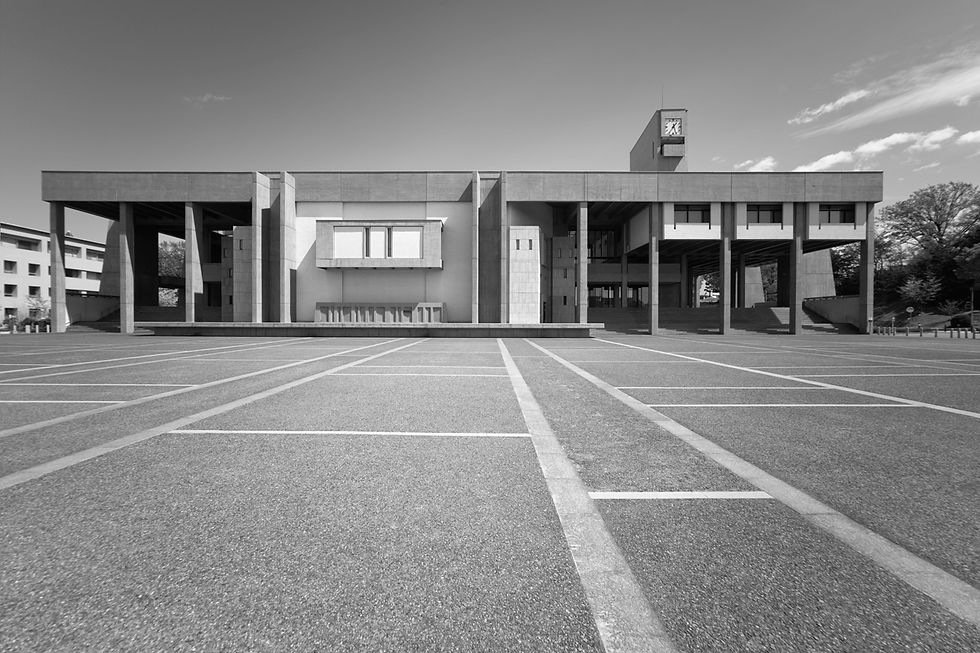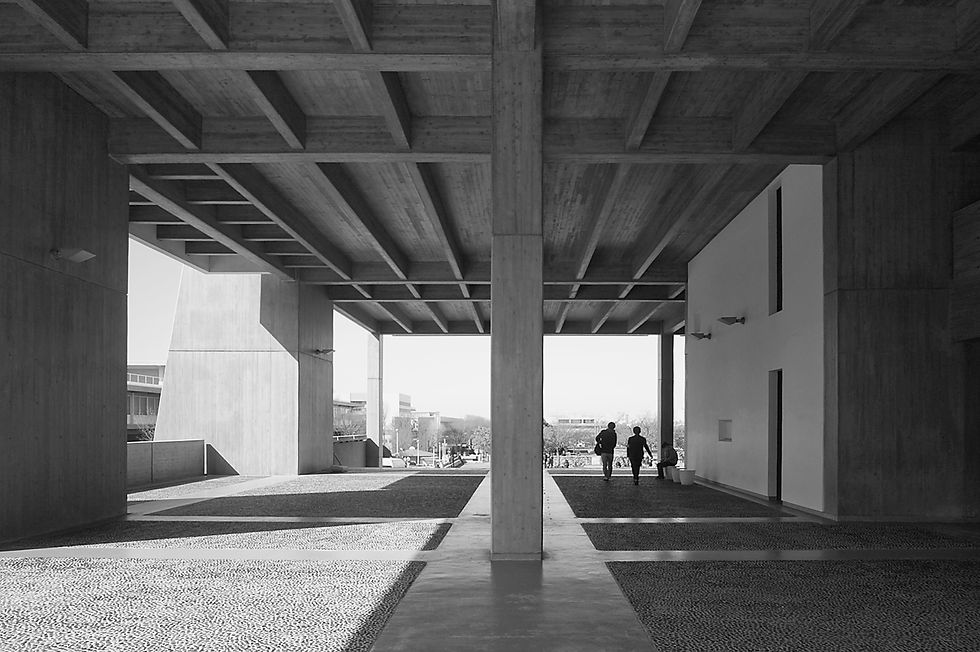Do|Co|Mo|Mo|Japan|10 Toyoda Hall : Fumihiko Maki
- John Barr
- Aug 30, 2019
- 7 min read
Updated: Apr 20, 2023

Do|Co|Mo|Mo is an international organisation dedicated to the Documentation and Conservation of buildings, sites and neighbourhoods of the Modern Movement. The Japanese branch has selected 100 works as representative of the development of the Modern Movement in Japan.
In a series of short posts I will feature some of the selected works that I have had the chance to visit and photograph. This post features the Toyoda Hall (also known as the Toyoda Auditorium) located on the campus of Nagoya University, designed by Fumihiko Maki and built in 1960...
Background
After graduating from the University of Tokyo Maki went to the USA and studied at Cranbrook Academy of Art and the Harvard Graduate School of Design. Later he taught at Washington University in St. Louis and at Harvard. Before returning to Japan, where he established his own office in 1965, he worked with SOM and in the office of Josep Lluís Sert, who was also dean of Harvard Graduate School of Design when Maki studied and taught there, and a board member of the Graham Foundation from which Maki received a fellowship grant.
The Toyoda Hall is Maki’s debut work in Japan. The project was completed in 1960 when he was 32 years old and design work was begun in the late 1950’s. Around the same time he completed the Steinberg Hall at Washington University in St. Louis.1 In both cases the projects were designed and built before Maki had formally established his office in 1965, and while he was still an associate professor at Washington University and a Graham Foundation Fellow.2 To receive two major commissions on two continents at such a young age, and before having an established office, is a mark of Maki’s talent but also of his internationalism and his ability to develop useful connections. These are attributes that he has retained throughout his long career, earning him major commissions and honours internationally, including the Pritzker Prize in 1993.

Toyoda Hall, Nagoya University : Fumihiko Maki : 1960
View of main entrance elevation from West.
Maki’s early career path was a departure from that of his predecessors, who had generally looked to Europe for their training and inspiration, primarily to France and Germany. Perhaps Japanese perceptions and interest in America had been changed by WWII and the subsequent US occupation of Japan, and Maki is the first major Japanese architect to have studied and worked in the USA before returning to establish his own office in Japan. Yoshio Taniguchi, who is nine years junior to Maki, followed a similar path, and the American influence (albeit largely from European émigrés to the USA) is noticeable in the works of both architects although, in Maki’s case, it becomes more noticeable in his later works.3 For the Toyoda Auditorium, his first major Japanese work, the influences are home grown: imported Corbusier viewed through the lens of ideas then being developed by the Japanese Metabolist group.
It is often forgotten that Maki was one of the original members of the Metabolist group, perhaps because he and Masato Otaka both moved away from Metabolism early, jointly developing the alternative idea of Group Form, which Maki has continued to develop throughout his career, most notably in a series of projects at Hillside Terrace in Daikanyama, Tokyo.4
Design
Maki’s early break with Metabolism raises the possibility that he was never truly committed to its cause or interested in its preoccupations. Nonetheless, the international high profile of the Metabolists no doubt presented opportunities to build useful connections for a young architect looking to return to Japan and establish himself.5
Although the Toyoda Hall has been described by Philip Drew in an interview with Maki as a forceful Metabolist work, Maki himself makes no such claims for it, describing it in the same interview as being in sympathy with the site conditions, whilst having a brutalist expression.6

Toyoda Hall, Nagoya University : Fumihiko Maki : 1960
Brutalist rather than Metabolist?
In truth the design for the Toyoda Hall is no more than nominally Metabolist. For those who wish to, it can be read as a superstructure with elements of accommodation plugged into or suspended from it. Toyoda was all about constructing a framework and inserting modules into it.7 Again, Drew’s words not Maki’s. It’s true that there is a large roof supported on columns, under which the functions of the building are arranged. But the same is true of many buildings. Kunio Maekawa’s Tokyo Bunka Kaikan, for example, uses the same technique and no one has thought to describe it as Metabolist.8 It could be argued that traditional Japanese architecture also uses the same technique: [supported on a grid of columns] a roof of heavy tiles is first laid out, and in the deep, spacious shadows created by the eaves the rest of the structure is built. (Jun'Ichiro Tanizaki 1933)9. Hang the label Metabolist on the architect and it becomes too easy to hang the same label on the architecture.

Toyoda Hall, Nagoya University : Fumihiko Maki : 1960
A roof is first laid out, and in the deep, spacious shadows created by the eaves the rest of the structure is built. Jun'Ichiro Tanizaki : In Praise of Shadows (1933).

Toyoda Hall, Nagoya University : Fumihiko Maki : 1960
A large roof supported on columns, under which the functions of the building are arranged.
Similarly there is a row of three ‘pods’ at the southern end of the main façade that appear to be suspended from the structure of the roof but in reality are supported from below by the standard means of beams spanning between columns. The appearance of ‘suspension’ occurs simply because there is a void below and because of a series of screens in front of the facade that gives the impression of separate 'boxes' that are, in reality, one structure. Any suggestion that these are flexible, short-life, structurally independent modules that could readily be inserted into or extracted from a fixed, long-life framework (one of the tenets of Metabolism) would be fanciful, as would the idea that the building is in any way designed to be capable of natural, incremental growth (the other tenet of Metabolism). As with Kikutake’s 1964 Hotel Tōkōen the effect is visual rather than practical.10


Toyoda Hall, Nagoya University : Fumihiko Maki : 1960
Elements that appear from a distance to be 'suspended boxes' (upper image) are revealed on closer inspection to be a slight of hand achieved by the addition of screens in front of the main facade (lower image).
Significance
The immediate and obvious significance of the Toyoda Hall is that it is Maki’s first built project and marks his arrival on the national and international stage. Some would claim that it is the first built example of Japanese Metabolism. I would argue that, if it is influenced by Metabolism at all, it is only nominally or stylistically Metabolist. For those who want to find them, there is the appearance of Metabolist elements but little of the substance of Metabolist principles.
Of more interest is the fact that, in the Toyoda Hall, we can find the genesis of ideas that Maki was to develop throughout his career and long after he had abandoned Metabolism. The most important of these is his preoccupation with the part and with the assembly of a composition of parts.
I have an interest in expressing the part in many ways…I like the part to speak up very strongly…When I start to design, quite often I have ideas, not just on the whole but on the parts. I play with that, and gradually the total picture comes out. In some cases, as in classical buildings, you start with the totality, or a clear whole, then you begin to make the parts to be fitted within this frame. But in the case of Spiral I decided to use a set of parts and it took many hours for me to come up with the final façade.11
The reference to Spiral is to the Wacoal Media Centre (commonly known as Spiral) in Aoyama, Tokyo, and is probably Maki’s most famous building. It is clearly, as described by Maki, an assemblage, or a composition, of parts, put together to create the whole. However, the Toyoda Hall is also an assemblage of parts, but of the classical variety described by Maki, where he has started with the totality and then made the parts to be fitted within the frame.

Spiral, Aoyama, Tokyo: Fumihiko Maki : 1985
A set of parts assembled to create the whole.




Toyoda Hall, Nagoya University : Fumihiko Maki : 1960
A set of parts created to fit the whole.
Another, related preoccupation is the detail : Architecture is not just an inflated minimalist sculpture, or a giant piece of furniture. What gives architecture its rhythm and scale is its detailing.12
Details, of course, are also parts – but at a small scale – and detailing is the art of bringing parts together. The Japanese architect Morihiko Yasuhara once described Maki to me as an architect of the joint. This is a succinct way of explaining Maki’s architecture as a series of joints that denote the bringing together of parts into a composed totality.
These ideas and this approach to design became overt and explicit in Maki’s later works and writing, but they are all to be found in his first built project – the Toyoda Hall.
All images by John Barr unless otherwise noted
© John Barr 2019
1. Sources vary in identifying year of completion for Steinberg Hall as 1960 or 1962.
Maki and Associates own website identifies it as 1962.
2. The Graham Foundation for Advanced Studies in Fine Arts is an American
organisation that provides funding for the development and exchange of ideas about
architecture and its role in the arts, culture and society. As it was founded in 1956,
Maki must have been one of the earliest recipients of a grant.
3. See previous post, Yoshio Taniguchi : The Man in the White Suit (August 21, 2018).
4. Maki's Daikanyama project comprises six phases, completed between 1966 and
1992 and, as one of DoCoMoMo Japan's selection of 100, will feature in a future
post.
5. For more on the Metabolists see previous post, Kiyonori Kikutake : The Strange
Case of Dr. Jekyll and Mr. Hyde (June 29, 2018).
6. Philip Drew in conversation with Maki after Maki's 2013 CCAA Talk at the Darling
Quarter Lecture Theatre in Sydney.
7. Ibid.
8. See previous post, In Search of Japan-ness : Part 1 : Putting Lipstick on the Gorilla
(Sept 3, 2017).
9. Tanizaki, Junichiro. In Praise of Shadows. Translated by Thomas J Harper and
Edward G Seidensticker. Vintage Books (2001) pg.28.
10. See previous post, Kiyonori Kikutake : The Strange case of Dr. Jekyll and Mr. Hyde
(June 29, 2018).
11. Excerpts from Maki's interview with Serge Salat and Françoise Labbé, Geneva (June
24 1986).
12. Maki, Fumihiko. The Public Dimension in Contemporary Architecture. Exhibition
Catalogue for Maki, Isozaki, New Public Architecture : Recent Projects. Japan
Society, New York (May-June 1985).




Comments